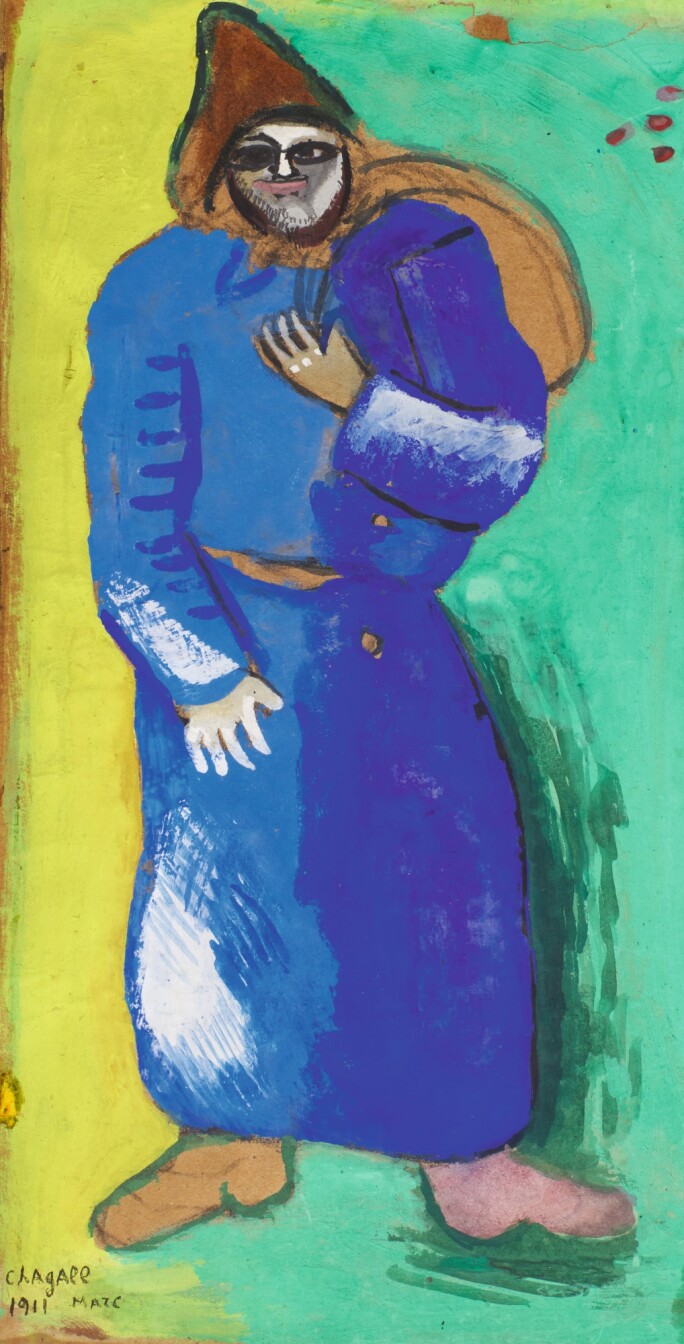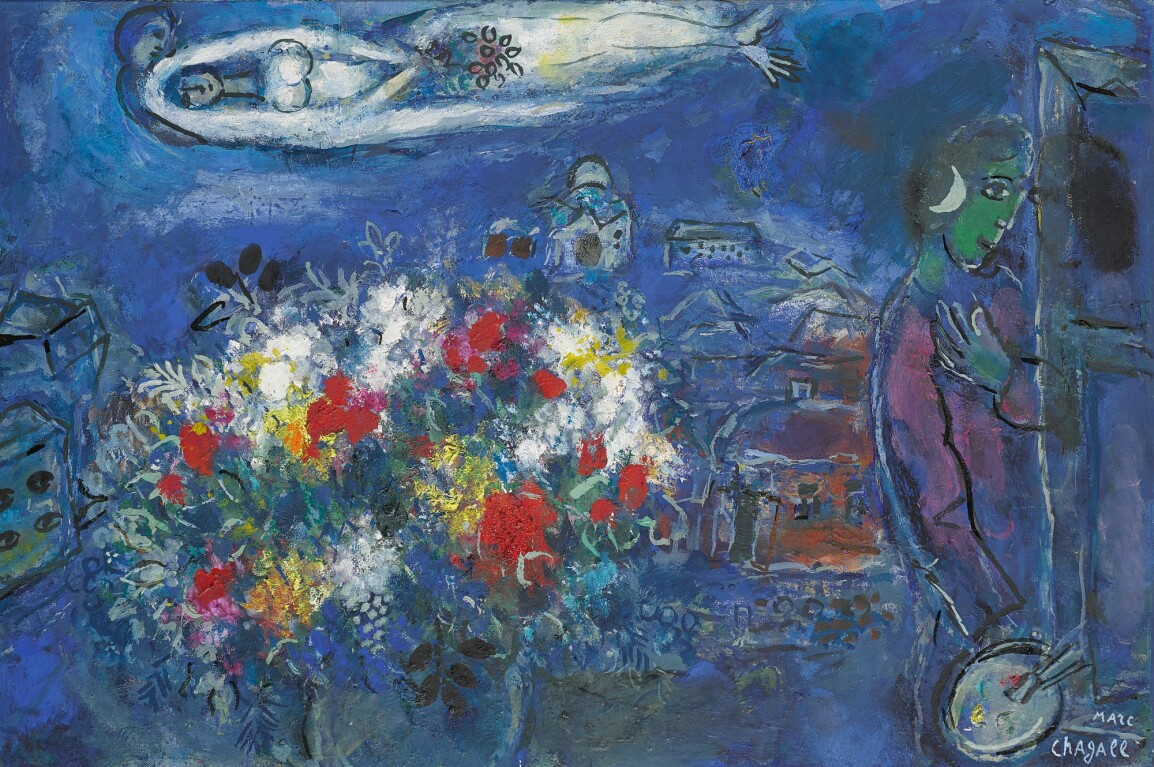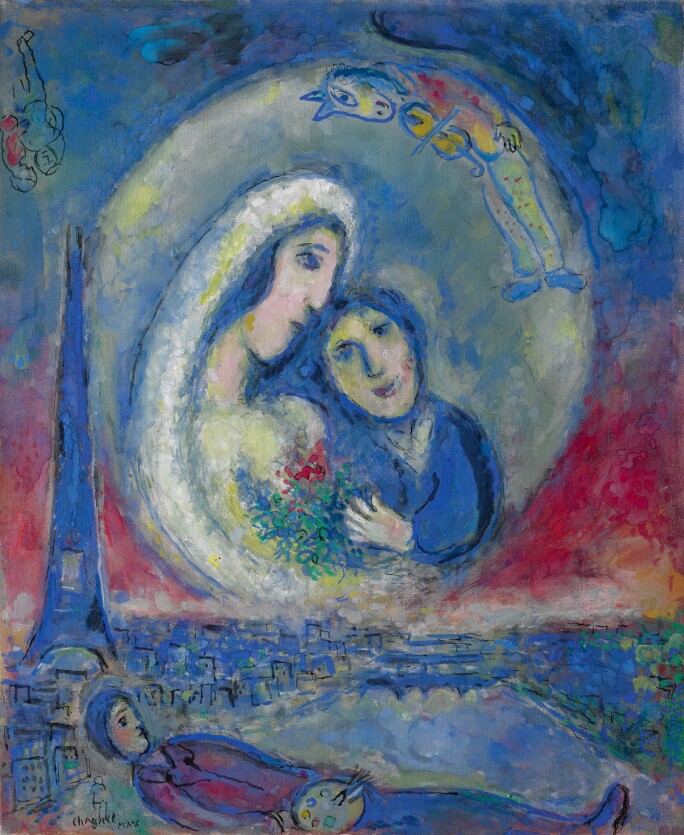Unearth artist Marc Chagall’s fantastical oeuvre, on offer in Sotheby’s Impressionist & Modern Art Day and Evening sales this November.

M arc Chagall was born Movsha (Moses) Shagal in July 1887 in Vitebsk, a village in Belarus. Chagall witnessed the most momentous occasions of the twentieth century, including two World Wars, the Russian Revolution and construction of the Berlin Wall, which shaped his life and artwork. Chagall’s first sojourn in France occurred in 1910 when he was only twenty-three; the young artist won an art scholarship to Paris in 1910, and soon moved to La Ruche, one of the city’s Cités d’artistes.
Situated behind the abattoirs of Paris, this twelve-sided building with its hidden garden housed 140 studios which were filled with young painters, sculptors, poets and bohemians from all over the world. This experience proved seminal in his artistic development, as his stay brought him into contact with luminaries such as Léger, Soutine and Modigliani.
In the following decades, Chagall would be influenced by the Surrealists in Paris but never considered himself a part of their group. Instead he chose to exhibit alongside European artists exiled in New York in the 1940s. Though he actively engaged in the Parisian artistic community, Chagall used art first and foremost as a means of personal expression.

After the onset of World War II, Chagall sought refuge in the Unites States, where from afar the artist was deeply affected by the war and its atrocities. As European liberation neared, Chagall grappled not only with the pain of world events, but also with the tragic loss of his beloved wife Bella, who passed away unexpectedly in 1944. Exacerbated by grief, Chagall’s exile was prolonged until 1948. When the artist finally returned to his adopted home country of France, he eschewed the capital and instead settled on the Côte d'Azur where many of his fellow artists like Matisse and Picasso had also taken up residence.
The Sotheby’s Impressionist and Modern sales this season contain a rich offering of pieces by Chagall that traces the artist’s visual vocabulary through his long and illustrious career. Below, preview the artworks.
Le Colporteur, 1911
C hagall’s oeuvre is replete with folkloric imagery from his childhood in Vitebsk. The figure of the peddler, with a sack full of wares on his back, is central among these. In this exceptional early gouache, Chagall employs his characteristic blocks of vivid color to create a charming image of the vendor.
“Chagall's great lyrical breakthrough came around 1911. This is the moment when metaphor, with him alone, made its triumphal appearance in modern painting. In order to complete the deconstruction of spatial planes that had been prepared by Rimbaud and at the same time free the object from the laws of weight and gravity, breaking down the barrier between elements and kingdoms.”
Le Satyre et le passant (Fables de la fontaine), circa 1926-27
T he illustrations for La Fontaine’s fables which Chagall began in 1926 are among his most imaginative works. The complete set of etchings derived from the gouaches was finished by 1930 and finally published in 1952.
The commission from the art dealer Ambroise Vollard was prestigious for Chagall, earning him almost 200,000 francs. Having left the constrained conditions of post-Revolutionary Russia only a few years previously, Chagall and his first wife Bella enjoyed some of their happiest years together in Paris at this time, buoyed by their first real period of financial stability and his renewed sense of artistic purpose. Bella would read the fables aloud to her husband as he developed his designs, and his gouaches of this period owe much to their joint expeditions into the countryside where they reacquainted themselves with rural life.
In La Fontaine’s tale, a cold and hungry traveler seeks shelter with a satyr and his wife. They are impressed to learn that the traveler keeps warm by blowing on his fingers, but when the man blows on his soup and explains that this is to cool it down, the straightforward satyr drives him out of the cave for double-dealing.
Le Ciel embrasé, 1952-54
W hen Chagall returned to Paris from the United States in August 1948 he was met with adulation, celebrated as one of the country's great modern artists alongside Picasso and Matisse and granted a room of his own in the French Pavilion at the Venice Biennale of that year. The return also marked a lightening of tone in his work. With his exile over and the period of mourning for Bella drawing to a natural close, he decided to resettle in Saint-Paul-de-Vence where he bought a house overlooking the sea. Chagall found the light and color of the south irresistible, like so many artists before him, and it was to remain his principal home to the end of his life. As Chagall himself once stated:
“As I got nearer to the Côte d’Azur, I experienced a feeling of regeneration, something I hadn’t felt since childhood. The smell of flowers, a sort of new energy poured through me... Perhaps I am feeling the years, but anyway this place has become to me like my hometown Vitebsk. As if I was rejuvenated, and that I was waiting for something. And this flower-filled world colored my new life.”
Chagall utilizes intense Mediterranean reds and yellows in a composition bisected by a diagonal band of Vitebsk rooftops with the figures of bride and groom lower right. Contributing to the new impetus in his work at this time was his meeting with Varvara Brodsky in 1952, an energetic young Ukrainian whom he married a few months after executing the work.
Fleurs de St. Jean-Cap-Ferrat (Paysage méditerranéen), 1956-57
F or the artist, whose early childhood was filled with the music of his close-knit community, the symbol of the violin always reminded Chagall of his native Vitebsk and was often incorporated into his scenes painted in or about other towns. The folkloric characters of donkey and rooster, common in his scenes since his earliest works, reappear here as muted embellishments within the moonlit scene. As a stand-in for the artist and symbol of virility and love, the rooster would become an increasingly dominant motif in his later works, echoing his passion for the great loves of his life.
The bottom portion of the canvas is devoted to the placid coastline of the work’s town, Saint-Jean-Cap-Ferrat, situated on a picturesque peninsula southeast of Nice, which served as the locus of Chagall’s artistic rebirth in 1949.
Bouquet dans la nuit, 1966
B ouquet dans la nuit blends the genres of still life, landscape and self-portrait into a classic Chagall dreamscape. The affinity between painting and dreaming is a motif in his work and the surreal elements are especially prominent here, from pairs of eyes on the walls of the left-hand house to the double appearance of the artist who is both seen behind his easel on the right and clasping his bride above.
In the paintings of Surrealists from the 1930s and 1940s the theme of night provides a backdrop for unconscious fears, but for Chagall the opposite seems true.
Au village rouge, 1968-73
D espite a sojourn in Russia after his French residency, where he watched the rise of Suprematism, and a period in America, Chagall’s childhood village remained at the forefront of his imagination and artistic expression. The town survived only in his fantasy as, having been construed mostly of wood, it was irrevocably destroyed by fire during World War II.
Au Village Rouge evokes the fantasy and harmony of Russian rural life; accompanied by a full moon and farm animals, the figures embody a world of lyrical childhood memories that provided emotional and mental refuge for the artist. Vitebsk was also the location where Chagall met his beloved first wife Bella, whom he married in 1915. Chagall has claimed:
“The fact that I made use of cows, milkmaids, roosters and provincial Russian architecture as my source forms is because they are part of the environment from which I spring and which undoubtedly left the deepest impression on my visual memory of the experiences I have.”
Le Songe, 1978
T he two great influences on Marc Chagall’s work were undoubtedly his first wife Bella and the city of Paris. Completed decades after Bella’s death and at a time when Chagall enjoyed international fame as a painter, Le Songe displays both the lover and the city through the artist’s iconic dreamscape style.
Its dominant blue and red hues imbue the work with an overwhelming sense of yearning, the lovers float alongside the Eiffel Tower and other recognizable symbols from Chagall's oeuvre. In contrast to Chagall’s more boldly colored works from this period, one cannot help but feel the artist’s nostalgia for a bygone era of his life.










